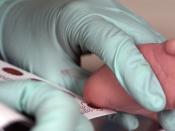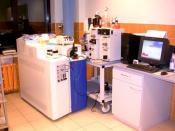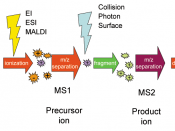Patrick So 8/5/2008
Research IV Mr. Batongbakal
Newborn Screening
Newborn screening is the process of testing and screening newborn babies for potentially dangerous conditions. It is a simple and inexpensive blood test from the heel or the inside of the elbow that is taken in the first 48 hours after birth. Alternatively, babies are tested within the first 24 hours and then are retested one to two weeks later. Either way, the sample is placed on a piece of filter paper to dry for four to six hours and then is sent to a laboratory for analysis. The benefit of newborn screening is that if one or more disorders are detected at birth, then intervention such as a special diet can be used to prevent early death or disabilities due to the disease. Even if the disease cannot be treated, its progression can be delayed and the quality of life can be improved and the lifespan can be extended.
In addition, newborn screening provides parents with earlier genetic counseling should they decide to have additional children and will also minimize the cost of unnecessary treatments.
The test, known as the Guthrie test, later on included additional disorders. These disorders often do not manifest at birth and thus the afflicted baby appears healthy at birth, but after some weeks or months, symptoms begin to develop. These include biotinidase deficiency (lack of biotinidase resulting in metabolic acidosis, seizures, hearing loss and developmental delay), congenital adrenal hyperplasia (deficiency of an adrenal enzyme and thus decreased cortisol resulting in lethargy, muscle weakness and dehydration), hypothroidism (deficiency of thyroid hormone triggering mental retardation and stunted growth), cystic fibrosis (altered synthesis of a protein involved in chloride ion transport resulting in abnormally thickened mucous secretions in the lungs and digestive systems) and galactosemia(deficiency in enzyme required to metabolize galactose resulting in liver damage when milk is fed).
Finally, in the 1990's tandem mass spectrometry was developed, giving rise to Expanded Newborn Screening which detects up to forty additional disorders. To begin with, a tandem mass spectrometer is one of several types of analytical instruments known as mass spectrometers. They are used in many laboratories to analyze thousands of compounds and can be thought of as instruments that weigh molecules. Specifically, a tandem mass spectrometer can be imagined as two mass spectrometers connected by a chamber known as a collision cell. To begin with, a sample is sorted and weighed in the first spectrometer, decomposed into its molecules in the collision cell and then the fragments are again weighed in the second.
Although there are thousands and even millions of compounds found in the blood, only a few significant compounds, which have certain common and unique characteristics are mainly scanned for. These compounds are mostly members of a chemical class such as amino acids or acylcarnitines. Let me explain what they are. Amino acids are the building blocks or fatty acids and carnitine is a transportation system for fats in and out of the mitochondria. When these carnitines are binded with fats, they are known as acylcarnitines and they are identified by the size of the fat molecule attached. Tandem mass spectrometry can weigh those acylcarnitines and determine how much mass is present; the results display data as vertical lines whose location identifies mass while the height represents the quantity of the molecules.
In metabolic disorders, enzymes that help facilitate the catabolism of amino acids or convert fat to energy are defective. As a result, the breakdown of these compounds does not occur or vital products that generate fuels for the body are not made. These compounds then accumulate in the blood and become poisons. With expanded newborn screening, how much of those proteins can be determined. In addition, it reduces the false positive rate by more than tenfold but it requires specialized reagents, expert scientists, medical experts and the instruments themselves are expensive.
With newborn screening around, plenty of babies can be saved from the jaws of metabolic disorders. Though it can be quite expensive, especially in developing countries, it can give parents a fighting chance that their children will live a long and happy life.
alpha_one1990
Sources:
www.newbornscreening.com/cms/About_Newborn_Screening.shtml
www.savebabies.org/NBS/msms-chace.php
www.uchsc.edu/newbornscreening/
genes-r-us.uthscsa.edu/resources/newborn/overview.htm
www.fsma.org/FSMACommunity/LegislativeAgenda/NewbornScreening
www.marchofdimes.com/professionals/24279_9606.asp
mayomedicallaboratories.com/articles/newborn/1_history.html





